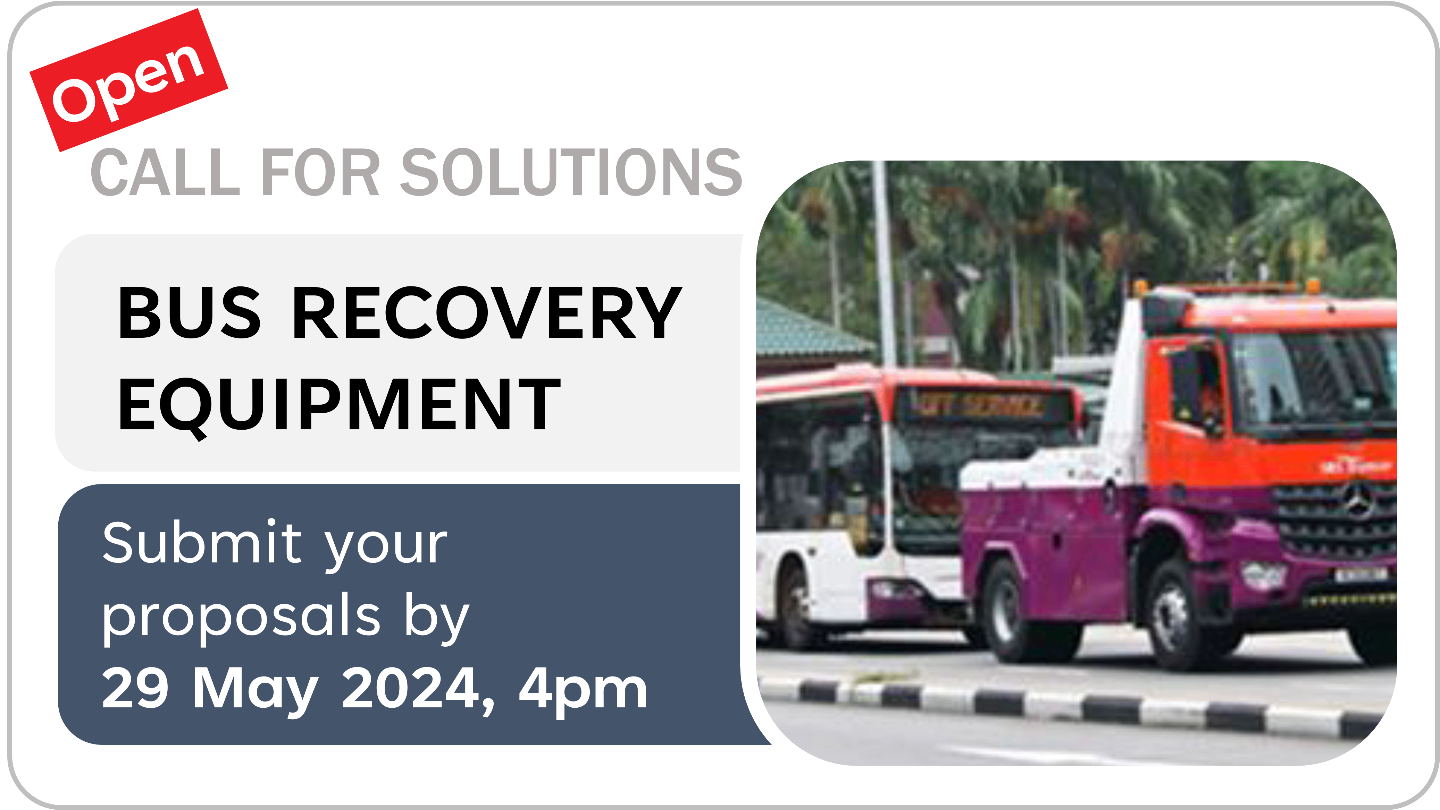| Challenge Owner(s) | Land Transport Authority (LTA) |
|---|---|
| Organiser(s) | Land Transport Authority (LTA) |
| Industry Type(s) |
Circular Economy & Sustainability, Land Transport, Urban Solutions
|
| Opportunities and Support | Co-development, proof-of-concept, trial and testings |
| Application Start Date | 17 April 2024 |
| Application End Date | 29 May 2024 |
| Website | Click here to learn more |
About Challenge
Call for Solutions - Bus Recovery Equipment
Fire safety is an important aspect of our bus depot operations, especially with the introduction of e-buses to our traditional diesel bus fleet. In the unlikely event of an e-bus fire, averting the spread of fire within the depot to prevent greater damage and loss of bus infrastructure and assets would be priority. Moreover, even when the fire from the e-bus is extinguished, there remains a possibility of re-ignition, which could be a result from sparks created by parts of the burnt bus being in contact with the ground or depot structures during the removal process.
To this end, LTA would like to seek your ideas for an appropriate post-fire recovery equipment (i.e. Bus Recovery Equipment) to remove burnt e-buses out of the building premises in a safe and efficient manner.
| Challenge Owner(s) | Land Transport Authority (LTA) |
|---|---|
| Industry Types(s) | Circular Economy & Sustainability, Land Transport, Urban Solutions |
Bus Equipment Recovery
As part of LTMP 2040, LTA has committed to electrify 50% of our public bus fleet by 2030. Just as we continually review safety enhancements for our traditional diesel bus fleets, we are looking to do the same for e-buses. With fire safety as an important aspect of our bus depot operations, one specific potential risk in the unlikely event of an e-bus fire is to avert the spread of fire within the multi-storey depot to prevent greater damage and loss of bus infrastructure and assets. Moreover, even when the e-bus fire is extinguished, there remains a possibility of re-ignition, which could be a result from sparks created by parts of the burnt bus being in contact with the ground / depot structures during the removal process.
To mitigate such subsequent fires, an appropriate post-fire recovery equipment would enhance the safety of the existing extraction process to relocate a burnt e-bus from a multi-storey bus depot into an isolated water containment structure. The water containment is located on the ground floor and away from the building structure. This would further enhance other existing fire mitigation measures (i.e. sprinklers to extinguish the fire and cool down the surrounding temperature, water curtains to prevent the spread to other group of buses).
What We Are Looking For
The proposal / solution should cover the following key requirements:
1. Extract the entire burnt e-bus out of the multistorey bus depot into an isolated containment located outside the depot building; The single direction ramps, with a gradient of 1:20, have a width of about 7 metres. The driveways within the bus park levels have a width of about 15 metres. The extraction should be carried out at a maximum overall height of 4.9m (max overall height of buses are 4.5m) from the bus parking level.
2. Equipment should not allow any part of the bus to be in contact with the surface of the ground during the extraction, should be able to secure the burnt e-bus and extract it out of the bus depot quickly and safely.
3. Support the maximum unladen weight of a double-deck e-bus, which is about 17 tons.
4. Design should facilitate ease of deployment at different bus depots. These bus depots would be located at different parts of Singapore. The deployment of equipment to bus depots could be through other transport means (i.e. low bedder vehicles).
5. The eventual design of the equipment could be provided by Dec 2024 and operationalized by Mar 2025 to allow for implementation at the new bus depot.
6. Operations and Maintenance (O&M) manual for the Bus Recovery Equipment, which should include detailed instructions in operating the equipment, preventive and corrective maintenance, maintenance schedule, scope of works, etc.
7. Operating model / Solution Case model of the equipment. Proposals would be
considered more favorably if tenderer has included solution for both equipment
development and subsequent deployment.
8. Provide an estimated cost of implementation for the proposed solution, and its estimated recurring operations / maintenance costs. Itemised costing of known components for both implementation and operations / maintenance is expected. As actual cost will subject to actual system configuration at point of implementation, appropriate assumptions to the cost estimation could be stated.
Sign up for the latest innovation updates
Customise your preferences to receive updates in industries you're interested in.
